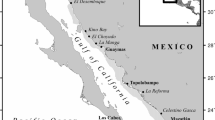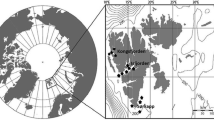Abstract
Litter size and details of the reproductive biology of female brown guitarfish Rhinobatos schlegelii from the Penghu Islands, Taiwan, are provided for the first time. Litter size ranged 1–14 (mean 8.5), with an embryonic sex ratio of 1:1. Vitellogenesis proceeded in parallel with gestation.
Similar content being viewed by others
Avoid common mistakes on your manuscript.
Introduction
The elasmobranch fishes (sharks and rays) are known to be susceptible to overexploitation due to their life history parameters, which result in limited productivity (Dulvy et al. 2014). Moreover, many species face unregulated harvest, with heavy exploitation in Asia (Lam and Sadovy de Mitcheson 2011). A large proportion of elasmobranch species are considered to be Data Deficient (Dulvy et al. 2014), in part due to a lack of information on life histories. To effectively manage exploited species, an understanding of a species’ ecology and life history parameters is paramount.
The elasmobranch diversity of Taiwan is one of the richest in the world (Ebert et al. 2013); however, there remains taxonomic uncertainty regarding aspects of the fauna, and information on the life history of many species remains scant. The status of the guitarfish fauna (family Rhinobatidae) of Taiwanese waters is also somewhat unresolved (see Ebert et al. 2013), but includes the brown guitarfish Rhinobatos schlegelii. This species occurs in the Northwest Pacific around Japan and in the East China and South China Seas (Compagno and Ishihara 2009). The habitat and ecology of this species are poorly understood. There is only limited published information on the reproductive biology of R. schlegelii, which is aplacental viviparous (Huizhen and Yunyi 1987) as are other members of the genus (Kyne and Bennett 2002; Grijalba-Bendeck et al. 2008).
Here, further information is presented on the reproductive biology of female R. schlegelii, based on limited opportunistic sampling at a Taiwanese fish landing site. As a species assessed as Data Deficient on the IUCN Red List of Threatened Species (Compagno and Ishihara 2009), new information on life history as presented here can help assess the species’ productivity and vulnerability.
Materials and methods
Thirteen mature female Rhinobatos schlegelii (740–985 mm total length, L T; 224–300 mm disc width, W D) were collected from the local fish market in Makung, Penghu Islands, Taiwan (23°33’57”N, 119°34’32”E). Local fisheries utilize a variety of gear (e.g., demersal longline, gillnet, handline) to target a range of inshore marine species, undertaking daily trips around the archipelago. Guitarfish specimens were sampled opportunistically from the market on 29 May 2005 and between 4 and 25 April 2006. Upon landing, individuals were photographed (Fig. 1), basic morphometric data taken (to the nearest 1 mm) and reproductive status assessed through dissection. If ovarian follicles or embryos were present, these were counted and measured, and embryos sexed. Means are given ± standard deviation. Regressions examining the relationship between maternal size and number of follicles/embryos were undertaken using W D for maternal size as the trunk was removed from one individual prior to examination.
Results
Both left and right ovaries and uteri are functional; developing follicles and embryos were found in both ovaries and uteri, respectively. The number of vitellogenic follicles (yellow-yolked follicles ≥ 4 mm) ranged from 11 to 29 and averaged 18.8 ± 5.8. There was no significant difference in the number of follicles observed in the right versus the left ovary (t test, n = 12, d.f. = 22, P = 0.884). Maximum follicle diameter (DFmax) ranged 7–28 mm. The number of vitellogenic follicles was not correlated with maternal size (W D) (R 2 = 0.149, P = 0.216).
Of the 13 females sampled, 10 were gravid [Electronic Supplementary Material (ESM) Table S1]. Litter size (number of embryos per female) ranged 1–14, with a mean of 8.5 ± 4.8. There was no significant difference in the number of embryos observed in the right versus the left uteri (t test, n = 10, d.f. = 18, P = 1.000). Embryos ranged in size from 26–207 mm L T. All embryos had well-developed yolk sacs, consistent with the aplacental (lecithotrophic) viviparous reproductive mode. Of the 85 embryos examined, 40 were female, 37 were male and 8 were unsexed. The overall embryonic sex ratio did not differ from parity (χ2 = 0.117, P = 0.732). Litter size was significantly correlated with maternal size (W D) (R 2 = 0.490, P = 0.036) (Fig. 2). Litter size = −37.850 + 0.182W D (a large female with a single embryo was removed from this analysis, as the likelihood that she had aborted most of her litter was high).
Discussion
The largest embryos (196–207 mm L T) retained large yolk sacs and could not be considered near term. As such, size at birth for this species is > 210 mm L T, probably considerably greater. Within the uteri, embryos and yolk sacs were enclosed in thin translucent ‘candles’. Larger embryos had the ‘blotchy’ dorsal pigmentation of adults (often weaker in adults). One female had begun to abort after capture, showing a pup emerging from the cloaca anterior end first, as has been shown in the ringstraked guitarfish Rhinobatos hynnicephalus (see Wenbin and Shuyuan 1993).
The presence of large (to 27 mm diameter) follicles in the ovaries of gravid females carrying well-developed embryos indicates that vitellogenesis proceeds in parallel with gestation, as observed in all species of Rhinobatos whose reproductive biology has been examined (see Kyne and Bennett 2002; Grijalba-Bendeck et al. 2008). Ovulation likely occurs soon after parturition, and these activities together with copulation are not seasonally distinct. This contrasts with studies from other rhinobatid genera, i.e., Aptychotrema (see Kyne and Bennett 2002) and Zapteryz (see Villavicencio-Garayzar 1995; Colonello et al. 2011), in which parturition and copulation were seasonally distinct. Synchronization of parturition and copulation is important for species which sexually segregate for most of their life cycle. Although direct information on sexual segregation in R. schlegelii is not available, all market landings examined during May 2005 and April 2006 were females, with no males observed.
The number of vitellogenic follicles was not found to be correlated with maternal L T, but this has been demonstrated in the common guitarfish Rhinobatos rhinobatos (see Abdel-Aziz et al. 1993). Counts of vitellogenic follicles do not provide an accurate assessment of reproductive output, given that not all follicles may ovulate, some will atrophy, and that the time period of follicle production is unknown. As with elasmobranchs in general, rhinobatids have low fecundity (Kyne and Bennett 2002). The litter size of R. schlegelii recorded here (range 1–14, mean 8.5) falls within the range demonstrated for other species of Rhinobatos and is close to the highest litter sizes in the genus which have been observed in R. rhinobatos (range 8–14, mean 12) (Abdel-Aziz et al. 1993) and the shovelnose guitarfish Rhinobatos productus (range 6–16, mean 9) (Villavicencio-Garayzar 1993). The mean litter size observed in the current study from the Penghu Islands is higher than that reported for R. schlegelii from near Diaoyu Island, East China Sea, by Huizhen and Yunyi (1987); they stated ‘in most pregnant females, two embryos are found each side…’
Litter size was related to maternal size in R. schlegelii, as has been shown in other species of Rhinobatos including R. hynnicephalus (see Wenbin and Shuyuan 1993; Kume et al. 2009), Rhinobatos lentiginosus (see Hensley et al. 1998) and Rhinobatos percellens (see Rocha and Gadig 2013), although it is acknowledged that only a low sample size was available in the current study. It is possible that abortion induced during capture accounted for some of the lower litter sizes of R. schlegelii examined in landings (most certainly, for the large individual who contained only a single embryo; ESM Table S1), which would affect the maternal size–litter size relationship found in this study.
The inshore waters of the Penghu Islands are heavily exploited by multi-species, multi-gear artisanal and industrial fisheries (Schluessel et al., unpublished data). There has been very limited regional assessment of the biology of many species landed. Here, limited results obtained from opportunistic sampling demonstrate the low reproductive output of R. schlegelii, consistent with other rhinobatids. While only a small number of individuals could be sampled, reasonably large numbers of this species were observed to be landed in May 2005 and April 2006. All individuals observed were females, and in May 2005 all were observed to be gravid. Rhinobatids have been shown to utilize shallow inshore waters for parturition and copulation (e.g., Villavicencio-Garayzar 1993), and our observations suggest that local fisheries may be harvesting reproductive aggregations of R. schlegelii. This fishing pressure, together with a suspected low population growth rate, highlights the need to reassess the conservation status of the species.
References
Abdel-Aziz SH, Khalil AN, Abdel-Maguid SA (1993) Reproductive cycle of the common guitarfish, Rhinobatos rhinobatos (Linnaeus, 1758) in Alexandria waters, Mediterranean Sea. Austr J Mar Fresh Res 44:507–517
Colonello JC, García ML, Menni RC (2011) Reproductive biology of the lesser guitarfish Zapteryx brevirostris from the south-western Atlantic Ocean. J Fish Biol 78:287–302
Compagno LJV, Ishihara H (2009) Rhinobatos schlegelii. In: IUCN (2013). IUCN Red List of Threatened Species. Version 2013.2. http://www.iucnredlist.org Accessed 10 March 2014
Dulvy NK, Fowler SL, Musick JA, Cavanagh RD, Kyne PM, Harrison LR, Carlson JK, Davidson LNK, Fordham SV, Francis MP, Pollock CM, Simpfendorfer CA, Burgess GH, Carpenter KE, Compagno LJV, Ebert DA, Gibson C, Heupel MR, Livingstone SR, Sanciangco JC, Stevens JD, Valenti S, White WT (2014) Extinction risk and conservation of the world’s sharks and rays. eLife 3:e00590
Ebert DA, White WT, Ho HC, Last PR, Nakaya K, Séret B, Straube N, Naylor GJP, de Carvalho MR (2013) An annotated checklist of the chondrichthyans of Taiwan. Zootaxa 3752:279–386
Grijalba-Bendeck M, Acero PA, González E (2008) Biología reproductiva de Rhinobatos percellens (Walbaum, 1792) (Batoidea: Rajiformes) en el Caribe colombiano. Revista de Biología Marina y Oceanografía 43:469–481
Hensley RA, McCoid MJ, Luer CA (1998) Litter variation in the Atlantic guitarfish (Rhinobatidae: Rhinobatos lentiginosus) with comments on distribution in the Gulf of Mexico. Southwestern Naturalist 43:501–504
Huizhen T, Yunyi H (1987) Report on the mode of reproduction and spawning period of Rhinobatos schlegeli. Investigatio et Stadium Naturae 7:55–57
Kume G, Furumitsu K, Tanaka S, Yamaguchi A (2009) Reproductive biology of the guitarfish Rhinobatos hynnicephalus (Batoidea: Rhinobatidae) in Ariake Bay, Japan. Environ Biol Fish 85:289–298
Kyne PM, Bennett MB (2002) Reproductive biology of the eastern shovelnose ray, Aptychotrema rostrata (Shaw &Nodder, 1794), from Moreton Bay, Australia. Mar Fresh Res 53:583–589
Lam VYY, Sadovy de Mitcheson Y (2011) The sharks of South East Asia – unknown, unmonitored and unmanaged. Fish Fisher 12:51–74
Rocha F and Gadig OBF (2013) Reproductive biology of the guitarfish Rhinobatos percellens (Chondrichthyes, Rhinobatidae) from the São Paulo coast, Brazil, western South Atlantic Ocean. J Fish Biol 82:306–317
Villavicencio-Garayzar CJ (1993) Biología reproductiva de Rhinobatos productus (Pisces: Rhinobatidae), en Bahía Almejas, Baja California Sur, México. Revista de Biología Tropica l41:777–782
Villavicencio-Garayzar CJ (1995) Reproductive biology of the banded guitarfish, Zapterix exasperata (Pisces: Rhinobatidae), in Bahía Almejas, Baja California Sur, México. Ciencias Marinas 21:141–153
Wenbin Z, Shuyuan Q (1993) Reproductive biology of the guitarfish, Rhinobatos hynnicephalus. Environ Biol Fish 38:81–93
Acknowledgments
The authors are grateful to J. Hsieh, the Penghu Marine Biology Research Center Makung, for assistance in the field, B.Séret for discussions on Taiwanese guitarfish and X. Chen for assistance with the Chinese literature. PMK was supported by the Marine Biodiversity and Northern Australia Hubs, collaborative partnerships supported through funding from the Australian Government’s National Environmental Research Program (NERP).VS was supported by a DAAD postgraduate scholarship, a University of Queensland postgraduate living stipend and University of Queensland Graduate School travel award.
Author information
Authors and Affiliations
Corresponding author
Electronic supplementary material
Below is the link to the electronic supplementary material.
About this article
Cite this article
Schluessel, V., Giles, J. & Kyne, P.M. Notes on female reproductive biology and embryos of the brown guitarfish Rhinobatos schlegelii from the Penghu Islands, Taiwan. Ichthyol Res 62, 347–350 (2015). https://doi.org/10.1007/s10228-014-0431-x
Received:
Revised:
Accepted:
Published:
Issue Date:
DOI: https://doi.org/10.1007/s10228-014-0431-x






